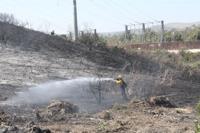Peak wildfire season in California is approaching, and because of historic rainfall from this past winter’s storms, local vegetation is at a greater risk of succumbing to fire.
Given that the storms followed years of drought, the Office of Gov. Gavin Newsom has compared the oncoming period to that of 2017, the most destructive wildfire season on record to that point, which also succeeded a massive spate of storms after a drought.
“Temperatures are heating up towards the end of this month, and there is a 90% likelihood of an El Niño developing by July,” the Office of the Governor saidin a press release late last month. “The tropical disturbances typically associated with an El Niño pattern could lead to increased lightning and thunderstorm activity.”
The rainfall contributed significantly to the growth of grasses and vegetation, creating more fuel for potential fires.
There are both pros and cons that can be associated with the rain, said Greg Barta, public information officer for the Orange County Fire Authority (OCFA).
The vegetation increased its moisture content because of the water it received and was able to maintain that content into the early spring.
“That kind of decreases the likelihood of a wildfire starting, and then even if it does start, it decreases the likelihood of it being as intense and causing as much damage,” Barta said.
He also concurred with the Office of the Governor’s projection that the growing grasses will dry out as temperatures rise, adding: “They will become an avenue for a fire to start and spread rapidly.”
With warmer weather comes a decrease in humidity, and while fires are essentially a threat year-round, according to Barta, Orange County is in the “dangerous window” of increased risk.
Cities such as San Clemente that have boundaries sitting against or areas within a wildland urban interface, or a location between unoccupied land and human development, have a greater risk of wildfires and resulting significant damage.
Barta mentioned the need for preparation, whether in terms of an exit plan for families or establishing defensible space around homes for homeowners, especially for those who live close to vegetation.
“You want to make sure that you clear any dead vegetation within 100 feet of your home, at a minimum,” he said. “If you see any vegetation out there, you want to get rid of it, especially within 30 feet of your home.”
Additionally, homeowners should look into drought-resistant plants and ensure they maintain a high moisture content and analyze their home to give it the best chance of surviving a fire.
Fires are often fueled by wind, Barta said, which can further cast embers long distances into roof eaves or into an attic. He further stressed making sure eaves are closed or boxed to prevent embers from entering, that there are no gaps between garage doors and the ground, and cleaning out dead leaves from rain gutters.
“As firefighters, if the fire’s coming in, we want to protect your home and defend it,” said Barta. “We want to have access into the backyard as easy as possible (and) access around the structure, so anything you can do to make sure that we have good access is also a huge benefit to us.”
He said firefighters call actions that protect houses from approaching embers “home hardening.”
In the unlikely event that you are still at home and notice a neighbor’s house is on fire, Barta said to first call 911 before going to alert that neighbor if they happen to be inside, but to not go inside yourself.
“Don’t put yourself in harm’s way, because then you become part of the problem, not part of the solution,” said Barta. “Then we have to focus our efforts on rescuing you and not the home.”
More information on OCFA’s online home assessment tool, wildfire hazard maps and other tools to help prepare for wildfires can be found on OCFA’s Ready, Set, Go webpage at ocfa.org/rsg.


